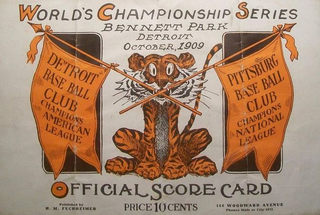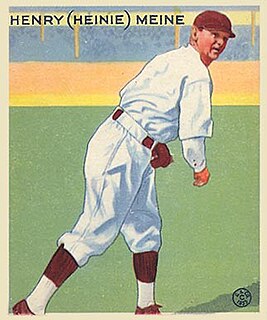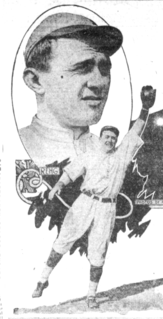Related Research Articles

The 1903 World Series was the first modern World Series to be played in Major League Baseball. It matched the American League (AL) champion Boston against the National League (NL) champion Pittsburgh in a best-of-nine series, with Boston prevailing five games to three, winning the last four. The first three games were played in Boston, the next four in Allegheny, and the eighth (last) game in Boston.

Riverside Park, located in Dawson Springs, Kentucky, was originally built in 1914 to serve as a spring training park for the Pittsburgh Pirates from 1914 to 1917. Sometimes referred to as Tradewater Park, it is the only known baseball park in Kentucky to have hosted a major league team since the Louisville Colonels folded in 1899. While the original stadium was destroyed in a flood in the 1930s, it was later rebuilt in 1999. Like the original stadium, the rebuilt park is reconstructed out of wood. It is the only ballpark of its kind in Western Kentucky.

Johannes Peter "Honus" Wagner, sometimes referred to as "Hans" Wagner, was an American baseball shortstop who played 21 seasons in Major League Baseball from 1897 to 1917, almost entirely for the Pittsburgh Pirates. Wagner won his eighth batting title in 1911, a National League record that remains unbroken to this day, and matched only once, in 1997, by Tony Gwynn. He also led the league in slugging six times and stolen bases five times. Wagner was nicknamed "The Flying Dutchman" due to his superb speed and German heritage. This nickname was a nod to the popular folk-tale made into a famous opera by another Wagner.

A baseball card is a type of trading card relating to baseball, usually printed on cardboard, silk, or plastic. In the 1950's they came with a stick of gum and a limited number of cards. These cards feature one or more baseball players, teams, stadiums, or celebrities. Baseball cards are most often found in the U.S. mainland but are also common in Puerto Rico or countries such as Canada, Cuba and Japan, where top-level leagues are present with a substantial fan base to support them. Some notable baseball card producing companies include Topps, Upper Deck Company, and Panini Group. Previous manufacturers include Fleer, Bowman, and Donruss. Baseball card production peaked in the late 1980s and many collectors left the hobby disenchanted after the 1994-95 MLB strike. However, baseball cards are still one of the most influential collectibles of all time. A T206 Honus Wagner was sold for $2.8 million in 2007.

Fred Clifford Clarke was an American Major League Baseball player from 1894 to 1915 and manager from 1897 to 1915. A Hall of Famer, Clarke played for and managed both the Louisville Colonels and Pittsburgh Pirates. He was a left fielder and left-handed batter.

In the 1909 World Series featured the Pittsburgh Pirates and the Detroit Tigers. The Pirates won the Series in seven games to capture their first championship of the modern Major League Baseball era and the second championship in the club's history. This Series is best remembered for the amazing play by the two best players at the time, Honus Wagner of the Pittsburgh Pirates, and Ty Cobb of the Detroit Tigers.
A night game, also called a nighter, is a sporting event that takes place, completely or partially, after the local sunset. Depending on the sport, this can be done either with floodlights or with the usual low-light conditions. The term "night game" is typically used only in reference to sports traditionally held outdoors. Although indoor sporting events often take place after local sunset, these events are artificially lighted regardless of the time of day they take place.

Thomas Andrew Leach was a professional baseball outfielder and third baseman. He played in Major League Baseball from 1898 through 1918 for the Louisville Colonels, Pittsburgh Pirates, Chicago Cubs and Cincinnati Reds.
The Western Association was the name of five different leagues formed in American minor league baseball during the 19th and 20th centuries.

Elton P. "Ice Box" Chamberlain was an American professional baseball player. He played in Major League Baseball as a right-handed pitcher from 1886 to 1896. In several seasons, Chamberlain finished in his league's top ten in a number of pitching categories, including wins, earned run average, strikeouts, and shutouts. During one of his best seasons, the 1888 St. Louis Browns won the American Association pennant with a 92–43 record. Although a righthanded pitcher, Chamberlain pitched the last two innings of an 1888 game with his left hand.

Norwood Oval is a suburban oval in the western end of Norwood, an inner eastern suburb of Adelaide, South Australia. It is owned by Norwood, Payneham & St Peters Council but managed by the Norwood Football Club. Though mainly used for Australian rules football, the oval has been used for a variety of other sporting and community events including baseball, soccer, rugby league and American football. It is the home ground for the Norwood Football Club in the South Australian National Football League (SANFL) and the primary home ground of the Adelaide Crows in AFL Women's (AFLW).

Henry William "Heine" Meine, sometimes "Heinie" Meine, was a professional baseball player. Meine was a right-handed pitcher who played for the St. Louis Browns in 1922 and for the Pittsburgh Pirates from 1929 to 1934. He was given the nickname "The Count of Luxemburg" on account of his operating a speakeasy/tavern in the Luxemburg section of St. Louis. He led the National League in wins and innings pitched in 1931 and compiled a 66–50 record in seven seasons of Major League Baseball.

Luther Haden "Dummy" Taylor was a deaf American right-handed pitcher in Major League Baseball from 1900 to 1908. He played for the New York Giants and Cleveland Bronchos and was one of the key pitchers on the Giants' National League championship teams of 1904 and 1905.
The 1935 Pittsburgh Pirates season was a season in American baseball which involved the Pirates finishing fourth in the National League.

Walter Phillip Rehg was a reserve outfielder in Major League Baseball, playing mostly as a right fielder for four different teams between the 1912 and 1919 seasons. Listed at 5 ft 8 in (1.73 m), 160 lb., Rehg batted and threw right-handed. He was born in Summerfield, Illinois.

Ban Johnson Park was a baseball stadium located in Hot Springs, Arkansas. It was also known as Whittington Park and McKee Park. The ballpark was located within today's Whittington Park Historic District and directly across from the still active Arkansas Alligator Farm and Petting Zoo.
Fogel Field was a baseball park located in Hot Springs, Arkansas, utilized for spring training games and baseball camps between 1912 and 1952. The site was also known as Fordyce Field and Holder Field. Fogel Field was built in 1912 as a spring training site for Major League Baseball teams. The field was named for Horace Fogel, President of the Philadelphia Phillies. Fogel Field hosted the Phillies (1912) and the Pittsburgh Pirates. The Kansas City Monarchs (1928), Homestead Grays (1930–1931) and Pittsburgh Crawfords (1932–1935) of Negro league baseball also used Fogel Field as their spring training site.
The Shulthis Stadium Grandstand was a baseball grandstand located in Independence, Kansas.
The Independence Yankees was a primary moniker of the minor league baseball teams in Independence, Kansas between 1896 and 1952. Independence teams played as members of the Kansas State League, Oklahoma-Arkansas-Kansas League (1907), Oklahoma-Kansas League (1908), Western Association (1911), Southwestern League (1921–1924), Western Association and Kansas-Oklahoma-Missouri League.
The Adrian Reformers were a minor league baseball team based in Adrian, Michigan in 1895. Adrian played as a member of the Class B level Michigan State League in 1895, also being known as the Adrian Demons. In 1895, Adrian, Michigan had two teams, also playing host to the Page Fence Giants of the negro leagues, with the two franchises sharing management. The Adrian Reformers signed six players from the Giants during the 1895 season, integrating the Michigan State League and leading to the moniker change. The Reformers/Demons were followed in Adrian by the 1909 Adrian Yeggs, who began play in the Southern Michigan League.
References
- ↑ "Top 100 Teams". MiLB.com. 2001. Retrieved May 9, 2017.
- ↑ Cy Blanton statistics
- ↑ "First Night Game in Organized Baseball Marker". Historical Marker Database. Historical Marker Database. July 25, 2012. Retrieved May 1, 2015.
- ↑ Light, Jonathan (1957). The Cultural Encyclopedia of Baseball (Second ed.). McFarland & Company. p. 670. ISBN 0-7864-2087-1.
- ↑ Eddleton, Oscar (1980). "Under the Lights". Baseball Research Journal: 37–40.
- ↑ Levitt, Daniel (2008). Ed Barrow, the Bulldog who Built the Yankees's First Dynasty. University of Nebraska Press. p. 25. ISBN 978-0-8032-2974-7 . Retrieved 27 March 2016.
- ↑ Samoray, Jeff. "A "Basket of Fresh Goose Eggs"". Society for American Baseball Research. Retrieved 26 March 2016.
- ↑ Bloodgood, Clifford. "1931, a Test for Night Baseball" (April 1931). Baseball Magazine.
- ↑ "Big Light Rush Staged in 1930 After Two Tests" (January 24, 1935). The Sporting News.
- 1 2 Bowman, Larry. "I Think it is Pretty Ritzy, Myself" (PDF). KansasHistory. Kansas State Historical Society. Retrieved 23 March 2016.
- ↑ Metcalf, Mark. "Producers Park Grandstand" (PDF). Kansas State Historical Society. Kansas State Historical Society. Retrieved 23 March 2016.
- ↑ Rives, Bob (1998). "Good Night". The National Pastime (18): 21–23.
- ↑ Sumner, Jan (2015). Independence, Mantle, and Miss Able (First ed.). Jadan Publishing. pp. 6–40. ISBN 978-0-9703197-1-5.
- ↑ "Today's Date in History". Facebook. National Baseball Hall of Fame Museum. Retrieved 23 March 2016.
- ↑ "Baseball at Night". Smithsonian American Art Museum. Smithsonian American Art Museum. Retrieved 23 March 2016.
- ↑ "On This Date". Chicago Tribune. Chicago Tribune. Retrieved 23 March 2016.
- ↑ Hagerty, Tim (February 22, 2015). "Multiple cities claim to have hosted the first night game in baseball history". The Sporting News. Retrieved May 1, 2015.